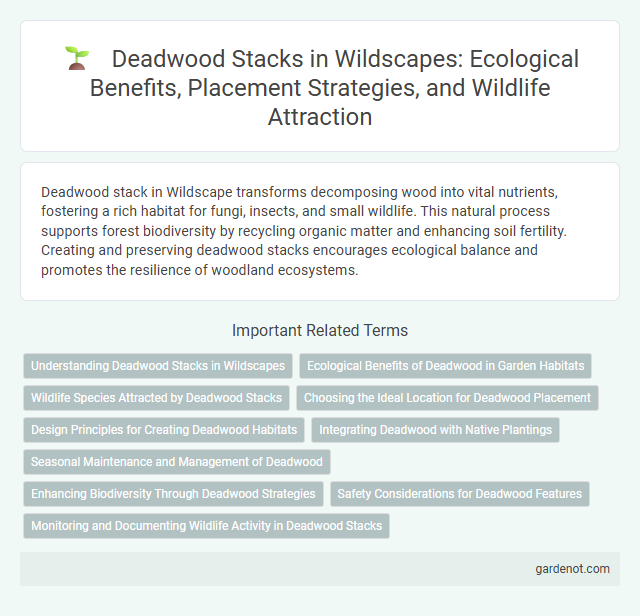Deadwood stack in Wildscape transforms decomposing wood into vital nutrients, fostering a rich habitat for fungi, insects, and small wildlife. This natural process supports forest biodiversity by recycling organic matter and enhancing soil fertility. Creating and preserving deadwood stacks encourages ecological balance and promotes the resilience of woodland ecosystems.
Understanding Deadwood Stacks in Wildscapes
Deadwood stacks in wildscapes are crucial ecological structures formed by the accumulation of decaying wood, providing essential habitats for diverse wildlife species. These stacks promote biodiversity by supporting fungi, insects, birds, and small mammals through nutrient recycling and shelter. Understanding the formation, composition, and ecological roles of deadwood stacks enhances conservation efforts and the management of natural habitats.
Ecological Benefits of Deadwood in Garden Habitats
Deadwood stacks in garden habitats create vital microhabitats supporting diverse insect populations, fungi, and mosses, enhancing biodiversity and soil health. Decomposing wood enriches the soil with organic matter, promoting nutrient cycling and moisture retention essential for plant growth. These ecological benefits increase overall ecosystem resilience and provide shelter for beneficial wildlife, including pollinators and predators of garden pests.
Wildlife Species Attracted by Deadwood Stacks
Deadwood stacks provide critical habitat for a variety of wildlife species, including woodpeckers such as the black-backed and pileated woodpecker that feed on insects tunneling through decaying wood. Small mammals like bats and insects such as beetles and ants are also attracted to these stacks, utilizing the crevices for shelter and breeding sites. This biodiversity hotspot supports a complex food web, enhancing overall ecosystem health and resilience.
Choosing the Ideal Location for Deadwood Placement
Selecting the ideal location for deadwood placement in a wildscape is crucial for supporting local biodiversity and enhancing habitat complexity. Position deadwood in shaded, moist areas to provide shelter for amphibians and insects while avoiding overly exposed spots that can accelerate decay. Incorporating deadwood near native tree roots and water sources maximizes its ecological benefits by promoting fungal growth and offering refuge for wildlife.
Design Principles for Creating Deadwood Habitats
Deadwood stack design prioritizes structural complexity to mimic natural fallen trees, providing essential habitats for diverse wildlife such as insects, fungi, and small mammals. Incorporating varied wood types and moisture levels enhances biodiversity by offering multiple microhabitats within the stack. Positioning stacks in shaded or semi-shaded areas supports fungal growth and moisture retention, crucial for maintaining ecological balance in wildscape environments.
Integrating Deadwood with Native Plantings
Integrating Deadwood with native plantings enhances habitat complexity and supports local biodiversity by providing essential shelter and food sources for wildlife. Native plants benefit from the microhabitats created by Deadwood stacks, which retain moisture and promote soil health. This synergy improves ecosystem resilience, fostering a balanced and sustainable environment in Wildscape restoration projects.
Seasonal Maintenance and Management of Deadwood
Seasonal maintenance of deadwood involves careful assessment and selective pruning to preserve habitat structure and biodiversity. Effective management balances removing hazardous or decayed wood while retaining essential ecological functions such as providing shelter and nutrients for wildlife. Implementing seasonal guidelines ensures deadwood supports forest health, promoting regeneration and sustaining key species throughout the year.
Enhancing Biodiversity Through Deadwood Strategies
Deadwood stack habitats play a crucial role in enhancing biodiversity by providing shelter, breeding grounds, and food sources for a wide array of species, including insects, fungi, birds, and small mammals. The preservation and strategic placement of deadwood in ecosystems support nutrient cycling and promote habitat complexity, vital for maintaining ecological balance. Integrating deadwood strategies in wildscape management fosters resilient ecosystems and encourages species diversity.
Safety Considerations for Deadwood Features
Deadwood stacks in Wildscape require careful safety considerations to prevent structural instability and potential hazards. Proper anchoring and regular inspection of deadwood elements reduce risks from falling branches or collapse due to weather exposure. Using durable, treated wood and integrating deadwood features with natural growth enhances safety while maintaining ecological benefits.
Monitoring and Documenting Wildlife Activity in Deadwood Stacks
Deadwood stacks serve as critical habitats for diverse wildlife species, providing shelter and breeding grounds for birds, insects, and small mammals. Monitoring and documenting wildlife activity in these structures involves using motion-sensitive cameras and acoustic devices to capture species presence, behavior, and population trends effectively. This data is essential for conservation efforts, enabling researchers to track ecosystem health and make informed decisions on habitat management.
Deadwood stack Infographic

 gardenot.com
gardenot.com